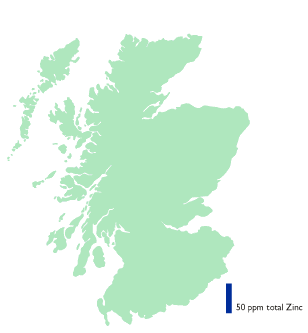Zinc
 The average concentration of zinc in the Earth's crust is around 80mg/kg, i.e. parts per million (ppm) although there is some variation of natural levels with rock type. However, Zn is widely used and there are a number of major entry routes into the soil environment including atmospheric deposition the recycling of organic wastes and the use of agrochemicals. Zn is an essential trace element for a range of plants and animals, including man. For humans, daily intake below the recommended value of around 15mg/day is likely to result in skin lesions, severe growth depression and a suppression of the immuno-response system. Zn deficiency can be seen in a wide range of plant species and is frequently observed as a chlorosis of the leaf tissue along with stunted growth. In contaminated soils, the principal impact was historically thought to be phytoxicity causing a depression of crop yield but there is now evidence that adverse impacts on soil micro-organisms may occur at lower levels than that which causes damage to growing plants. In the sample set studied here the zinc contents are on a par with those obtained for lead, particularly for transects 1 and 2, with transect means of 38 and 59 mg/kg, respectively. The mean contents in transects 3 and 4 are 94 and 67 mg/kg showing a significant increase form those for transects 1 and 2 but not to the same extent as that observed for lead. As with the other metals the values for soils receiving sewage sludge tend to have been adopted as environmental standards for soils but the values recorded here are below both the recommended (150mg/kg) and the maximum (300mg/kg) permissable values.
The average concentration of zinc in the Earth's crust is around 80mg/kg, i.e. parts per million (ppm) although there is some variation of natural levels with rock type. However, Zn is widely used and there are a number of major entry routes into the soil environment including atmospheric deposition the recycling of organic wastes and the use of agrochemicals. Zn is an essential trace element for a range of plants and animals, including man. For humans, daily intake below the recommended value of around 15mg/day is likely to result in skin lesions, severe growth depression and a suppression of the immuno-response system. Zn deficiency can be seen in a wide range of plant species and is frequently observed as a chlorosis of the leaf tissue along with stunted growth. In contaminated soils, the principal impact was historically thought to be phytoxicity causing a depression of crop yield but there is now evidence that adverse impacts on soil micro-organisms may occur at lower levels than that which causes damage to growing plants. In the sample set studied here the zinc contents are on a par with those obtained for lead, particularly for transects 1 and 2, with transect means of 38 and 59 mg/kg, respectively. The mean contents in transects 3 and 4 are 94 and 67 mg/kg showing a significant increase form those for transects 1 and 2 but not to the same extent as that observed for lead. As with the other metals the values for soils receiving sewage sludge tend to have been adopted as environmental standards for soils but the values recorded here are below both the recommended (150mg/kg) and the maximum (300mg/kg) permissable values.

